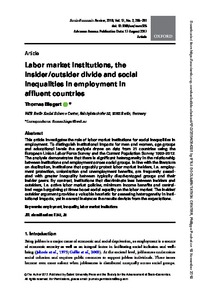Labor market institutions, the insider/outsider divide and social inequalities in employment in affluent countries

2019
17
2
April
255-281
labour market ; social inequality ; employment ; dual economy ; regulation ; trade union membership ; comparison
Labour market
https://doi.org/10.1093/ser/mwx025
English
Bibliogr.;Statistics;Charts
"This article investigates the role of labor market institutions for social inequalities in employment. To distinguish institutional impacts for men and women, age groups and educational levels the analysis draws on data from 21 countries using the European Union Labor Force Survey and the Current Population Survey 1992–2012. The analysis demonstrates that there is significant heterogeneity in the relationship between institutions and employment across social groups. In line with the literature on dualization, institutions that arguably protect labor market insiders, i.e. employment protection, unionization and unemployment benefits, are frequently associated with greater inequality between typically disadvantaged groups and their insider peers. By contrast, institutions that discriminate less between insiders and outsiders, i.e. active labor market policies, minimum income benefits and centralized wage bargaining at times boost social equality on the labor market. The insider/outsider argument provides a valuable heuristic for assessing heterogeneity in institutional impacts, yet in several instances the results deviate from the expectations."
Digital
The ETUI is co-funded by the European Union. Views and opinions expressed are however those of the author(s) only and do not necessarily reflect those of the European Union or the ETUI.